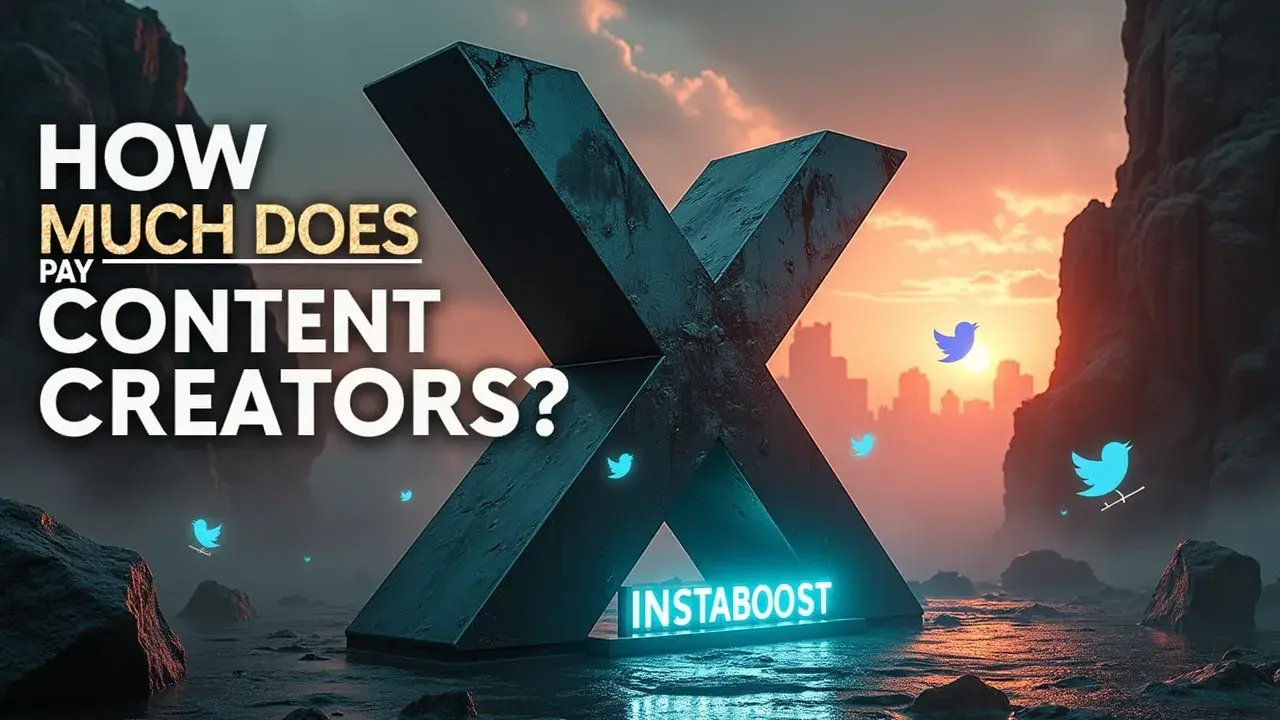How Much Does X (Twitter) Pay Content Creators?
Payouts generally mirror what audiences consistently watch rather than one-off spikes. Earnings tend to correlate with steady watch time and engagement quality, with a modest bump often appearing after the first week as performance settles. Rates per impression vary by audience, timing, and interaction depth, so rolling averages give a clearer picture than single-post peaks. Focusing on consistent output and tracking trends over time is the smart path to understand typical returns.
Why “How Much Does X Pay?” Starts With What You Keep People Watching
Most people ask for a flat rate, but payouts on X act less like a fixed price and more like a moving target shaped by attention, timing, and who’s actually engaging. X’s revenue share leans toward posts that sustain real watch time and deeper comments, not just a quick impression spike, so the better question is how your reach turns into retention. If you pair targeted promotion with clean analytics and a simple testing loop – two to three formats, A/B hooks, and a rolling 28 – 60 day view – you’ll get clearer readouts on cost per thousand impressions and what X pays creators at your size, and tools like a fast X profile boost can be folded into controlled experiments.
Early momentum helps when it’s qualified. Real comments, saves, and follows from aligned audiences tend to lift RPMs, while low-quality traffic muddies the signal and drags the baseline. Collaborations with creators your audience already trusts often beat raw ad spend because they compound session length and conversation, which the revenue formula favors. If you use paid boosts, match them tightly to intent – geography, interests, time of day – and track post-campaign decay so you’re not mistaking paid spikes for sustainable earnings. Expect a modest earnings bump to trail strong posts by a few days as placements catch up. Consistency across a month usually beats one breakout.
The path is simple, not easy. Set safeguards against botted engagement, work with reputable partners, and track RPM by content type, not just account-wide. Done this way, you won’t chase guesses – you’ll know your platform rate, where it flexes up, and which levers – retention signals, creator collabs, targeted promotion – reliably increase your payout.

Signals That Actually Move the Payout Needle
Our first real win came when we stopped trying to impress and treated “how much does X pay content creators” like a math problem with moving parts, not a mystery or a mood. We matched topics to clear intent and tightened our intros, and average watch time slid past the 8 – 12 second drop-off. The dashboard started telling a different story, with CPMs steadying and comment depth growing because prompts asked for specifics instead of generic applause, and we prioritized tactics that reliably grow X followers without muddying retention signals. That’s the credibility layer X quietly rewards – retention signals plus real comments.
If you’re using targeted promotion, aim it narrowly at lookalike followers who have already watched 50% or more of a clip. That early momentum turns into cheaper reach you actually keep. Pair that with clean analytics: two to three formats, one variable at a time, a rolling 28 – 60 day view, and a simple cost-per-impression log tied to revenue share. A reputable fast X profile boost can fit inside that loop when it’s calibrated – small bursts, frequency caps, and creative that mirrors your organic tone – so you measure lift, not noise. Collaboration compounds this. Creator collabs with overlapping but not identical audiences deliver higher-quality comments and reduce paid spend by importing trust.
The non-obvious insight is that payouts trend upward when you optimize for the second interaction, not the first. A tightened hook gets the view. A clear nudge to reply with context – what tool did you swap? – sparks the conversation that pushes the post into better inventory and steadier RPM. You won’t get a single flat rate, but you can engineer a reliable band if you keep your testing loop disciplined, your promotions qualified and timed, and your content built to convert reach into retention.
Design a Clean Revenue Loop
You don’t need more features – you need more clarity. Treat “how much does X pay content creators” like an operating system you can steer with clean inputs, readable signals, and tight feedback. Build a simple 28 – 60 day loop. Pick two or three repeatable formats, run one or two A/B hooks per format, and hold a fixed posting cadence so watch time can stabilize past the 8 – 12 second drop-off you’ve already seen. Pair targeted promotion with safeguards – qualified audiences, capped budgets, and exclusions for low-retention interest clusters – so early momentum supports, not poisons, your retention signals.
Use clean analytics to track three truths, not thirty: average watch time by post, comment depth per 1,000 impressions, and RPM or CPM by day of week. If you add a fast X profile boost or follower growth tool, slot it into controlled cohorts and label the posts. The lever works when it’s matched to intent and measured against a holdout. Collaborate with creators whose audiences overlap your topic, not just your vibe, and prompt specific replies that seed real comments you can reference in follow-ups. Aim for a frictionless path from reach to retention: a clear hook in line one, a single narrative promise, and a call to action that rewards attention with something concrete – a stat, template, or punchy takeaway.
Expect rates to swing. What steadies them is consistency and topic – market fit. The non-obvious insight is that your highest-paying posts often come from the most boring constraint – repeating the same test long enough to see the plateau – so you can reallocate budget toward formats that compound rather than chase a one-off viral spike on the creator economy search term of the week and increase X likes.
Stop Blaming the Algorithm – Audit Your Inputs
It looked solid on paper, then real life showed up. It’s easy to call payouts random, but the math fails when the inputs are messy – scattered topics, hooks that bury the lead, and promotions that spike followers while quietly hurting retention signals. If you’re asking how much X pays creators, the honest pushback is that revenue is usually a lagging indicator of watchability and clarity, not luck; for reference on platform signals, see engagement views for X as a baseline term creators use when benchmarking. When we matched topics to intent and tightened intros, CPMs didn’t just go up – they stabilized because people stayed through the first beats and commented with specifics.
That’s the standard for targeted promotion too. Qualified and reputable boosts that fit the audience and format can create early momentum if your testing loop is clean and your comments are real, not hollow. Pair two or three repeatable formats with one or two A/B hooks, and hold cadence long enough for the platform to trust your average watch time past that 8 – 12 second dip. Collabs help when the partner’s audience overlaps your intent – otherwise you buy reach and pay with session depth. If you want a practical benchmark for payouts per impression, track rolling 14 – 28 day averages against three inputs: intro completion, first-comment depth, and post-to-post retention.
The insight most creators miss is that monetization rises when your worst posts get less bad, not when your best post pops. That’s the clean revenue loop – tight formats, targeted promotion with safeguards, and analytics that read cause from sequence, not vibes. Do that and you’re not waiting on an algorithm. You’re feeding it the pattern it’s designed to reward.
Close the Loop: Turn Payouts Into a Forecast, Not a Surprise
Keep what sparks and drop what only soothes. If the question is how much X pays creators, the better move is to turn a clean system into a forecast you can steer. Track 28-day rolling averages for views, watch time past the 8 – 12 second cliff, and RPM by format.
Then set guardrails: a minimum hook retention rate, a minimum share of comments from non-followers, and a ceiling on low-intent promotions. Use targeted promotion and qualified creator collabs as accelerants only after a post clears your retention signals, and buy from partners matched to intent so early momentum feeds the algorithm instead of faking it. Keep two or three formats and give each a job. One for reliable payout, one for growth spikes, and one experimental slot. A/B two hooks per format, retire losers quickly, and archive baselines so you can tell when an RPM shift is platform-wide versus driven by your inputs. Tie every spend to a time-bound, trackable lift in engaged views, not just impressions.
People often ask how much per impression, but the payout trend follows session depth and real comments. When a post hits, point people with an in-thread CTA to the next piece to preserve session flow. When it misses, check input quality first, not the algorithm. If you want an add-on, use clean analytics or a lightweight attribution tool to tag spikes by source, and schedule collabs around a steady cadence; for reach tests, you can get more retweets on X without distorting intent signals if you gate them behind retention. The non-obvious bit: the payout curve often trails watchability improvements by about a week. Consistency compounds faster than chasing new features. Treat revenue like a forecast you update daily, and the question shifts from how much X pays to how precisely you can predict it.
Build a Payout Engine, Not a Lottery Ticket
Here’s the simple, slightly uncomfortable truth about how much X pays creators: your revenue rises when your system does. Treat each post like a small experiment with a clear hook, one viewer job-to-be-done, and a clean handoff to the next piece. That helps you see which inputs move RPM and which are just vanity. Pair formats with intent. Use short, high-velocity clips to earn non-follower comments and save rates, then follow with a thread or long-form to turn that attention into steadier watch time and ad-friendly sessions. Use targeted promotion sparingly and with safeguards – qualified audiences, frequency caps, and creative aligned to the first three seconds – so you add early momentum without weakening retention signals.
Collaborate with creators whose audiences share your watch habits, not just your topic, and watch the spillover. Do their viewers stick past the 8 – 12 second cliff on your posts next week? Clean analytics is the accelerator. Instrument UTMs for collabs and paid boosts, tag topics consistently, and keep a rolling attribution window so you can tell when a spike becomes a baseline.
If you’re benchmarking “how much X pays per impression,” anchor to your own 28-day RPM by format and audience segment, then forecast: number of posts × expected engagement views × retention-adjusted RPM. It’s not perfect, but it turns surprise checks into steerable targets. The non-obvious edge is disciplined disqualification. Say no to growth tactics that raise follower counts while lowering session quality. By keeping your floor high – hook retention, non-follower comment share, topic clarity – you protect the signals that price your inventory. Buying reach or tools works when the inputs are clean, the partner is reputable, and the goal is measured against watchability and fit, not ego and Twitter profile optimization.















